How to Create an SEO Content Strategy
18 Minute Read
At Twelve Three Media, we are uninterested in doing anything half-assed. We’re here to drive results for our clients. To do that efficiently and effectively, we’ve got to know exactly what action will bring the most value.
When we create a content strategy for SEO, we want to answer the user’s question. So, what is the question? That’s what we get paid to figure out! And we do it exceedingly well—so well, in fact, that we thought we’d share our process.
How do you develop an SEO content strategy that gets more organic traffic to your website and increases conversions? Read on to find out. We’ve got 12 steps in our content strategy (go figure!), and it will change your game. Not sure how to get started? Ask yourself these questions:
- Who Is My Target Audience?
- How Do I Use Keyword Research to Boost My SEO?
- What Insights Can You Gain from Competitor Research?
- How Do I Choose the Right SEO Content Topics for My Audience?
- Why Do I Need to Employ Different Types of Content?
- How Do I Turn My Research Into an Actionable Plan?
- How Do I Create Authoritative Content?
- Why Is Consistent Content Creation Important?
- How Often Should I Update Old Content?
- Why Is It Important to Drive Traffic to Your Website From Other Channels?
- How Do I Optimize My Content for SEO?
- Why Do We Track Content Performance?
Or, if you’d rather have the experts handle it, contact Twelve Three Media now.
What Is an SEO Content Strategy?
A content strategy for SEO is a thoroughly researched and skillfully executed framework that aims to draw more organic traffic to your website, resulting in more of the conversions you’re aiming for. A precise and purposeful plan caters to your audience and draws them in. It starts with a click on the SERP, providing them a unique, informative, and authoritative answer to their question that draws them further into the site and ultimately establishes a mutually beneficial relationship between the customer and your business.
A kickass content strategy for SEO is all about creating and promoting material that matches user intent. By fulfilling—and exceeding—their expectations, the user is hooked, which converts to generated leads.
For impactful content marketing, having a solid SEO strategy is momentous. When content is all over the place, search engine bots struggle to index your site correctly, recognize your authority, and rank your pages. SEO content is specifically designed to rank higher in search results, establishing credibility and trust with your audience.
You can’t fly by the seat of your pants when building a successful SEO content strategy. It’s called a strategy because it is strategic. Every step serves a purpose and contributes to the whole. A plan keeps you on track, reminds you to answer that question, and ensures the right people are getting to read it. Frankly, without an SEO content plan, all your content will be at sea on page 20, never to be seen by the human eye again.
Our Take
If you haven’t invested in a content strategy for SEO, you haven’t really invested in your business.
Why Do I Need a Content Strategy for SEO?
The benefits of a detailed and deliberate SEO content approach should already be obvious, but if not, let us reiterate:
- A superior content strategy attracts more traffic to your website by achieving higher SERP rankings.
- It elevates the quality of your content, establishing greater authority and enhancing the user experience.
- It consistently reminds you to align your content with users’ wants and needs.
- It saves you cash as a cost-effective solution to boost your online presence.
The purpose of SEO is to improve your rankings in search engines. “And when it comes to search engine optimization, make no mistake: Content is KEY” (BackLinko). But you need a foolproof strategy to do it effectively. Make sure you are utilizing every opportunity to rank better and grow positive engagements with your audience.
Our Take
If you don’t do it, someone else is going to, and you’ll be stuck sucking their dust. When the opportunity is right in front of you, you’d better grab it by the jewels.
What Are the 12 Steps in Creating an SEO Content Strategy?
So, let’s get back to the question: How do you develop an SEO content strategy that gets more organic traffic to your website and increases conversions? We will take you step by step through a flawless content strategy for SEO. Do with this what you will, or let us do it for you.
1. Study Up on Your Target Audience
The most important factor in your content plan is your target audience. Hands down! You need to understand what resonates with them. What do they need? What do they want? What’s not even on their radar that they’re going to love?
The user should always be your main focus. You legitimately want to give them what they need and want and a little more. This isn’t just how you’re going to rank well. It’s how you’re going to build lasting relationships with your clientele.
To establish who this audience is, consider the demographics of your current audience and those you’d like to attract. Delve into their interests and behaviors.
There are free audience finders out there. But you might benefit even more from asking your current users about themselves. Everyone likes to talk about themselves! Run surveys and quizzes and analyze the data to make sure you know your audience.
Our Take
There’s no point in trying to hoodwink your audience. They will know soon enough that you’re full of it. Instead, devote yourself to listening. Learn how to anticipate their needs. That way, they’d be crazy not to stick with you.
2. Get Your Keyword Research Done
Now that you know your audience, what are they searching for? Their searches will dictate the content you are going to create. And this initial keyword research will be vital to your SEO content strategy.
Put yourself in the audience’s shoes and search like a user. Research what keywords could bring a user to your website via the SERPs. You’ll want a variety of keywords. Some of these need to be general enough to encompass the purpose of your site. Then, you’ll dig deeper to get more specific.
There are a variety of ways to do this research. You can use a keyword research tool like Moz Keyword Explorer or Semrush. But there’s a lot you can do on your own. Try popping your general keyword into the Google search bar to see what variations autocomplete comes up with. Search possible keywords and make a note of the People Also Ask queries that are generated.
All of this information is valuable. It lets you know what your audience is searching. However, you must always evaluate whether the search intent of these keywords will be valuable for your business.
SEO Content Strategy Example:
You own a gourmet pizza restaurant. You decide to target the keyword “best cheese pizza.” You do make the BEST cheese pizza, after all. However, if you don’t consider the search intent, you’ll be attracting a bunch of home chefs looking for “best cheese pizza” recipes.
Instead of this more informational keyword, perhaps make it navigational: “best cheese pizza near me.” Now you’re enticing locals who can’t wait to snack on your scrumptious slices!
Another factor to consider is the search difficulty of the keywords you want to master. The more general the keyword, the greater the competition.
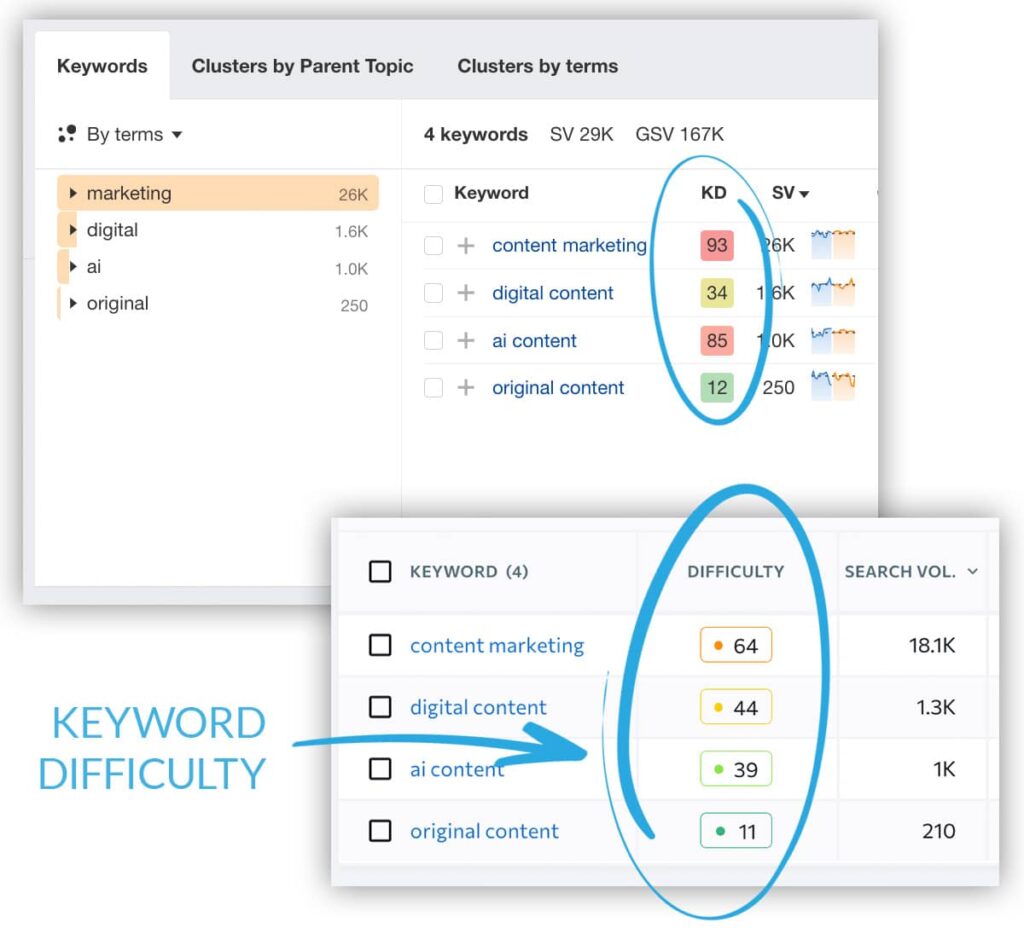
Meanwhile, long-tail keywords are more specific and attainable. The tactic you want to use is to support the generic keywords with related long-tail keywords.
Read More: How Fixating on the Wrong Keywords Kills Your SEO Strategy
Our Take
Keyword research creates a solid foundation for a successful SEO content plan. Skimp here, and you might as well go home.
3. Spy on Your Competitors
It’s never about envy or jealousy. It’s simply an acknowledgment and appreciation for how your competitors are rocking it. And if they’re doing it well, you’d be remiss in not studying what they’re doing right.
Investigate who is ranking well for the keywords you want to go after. What are they writing about? What kind of content are they using to connect with your audience? What sets them apart from the rest?
Take this information and determine how your business can do it even better. How can you stand out? How can you take their strategy and make it more authoritative, trustworthy, helpful, and unique to your business?
Our Take
Google and your audience want you to serve up something no one else can. The only way to successfully do that is to see what everyone else is offering, one up it, and make it your own.
4. Choose the Right SEO Content Topics
Choosing topics that will entice your audience is a big part of your content strategy. The goal is to guide the user from the SERP to your website. If you don’t provide them with an answer to their question, they won’t make it past GO.
Choosing the right SEO content topics for your audience involves strategic research and understanding user intent. Here’s how to get it right:
- What Are Your Audience’s Needs? You know who your audience is. Now, what kind of content are they looking for? Use tools like People Also Ask (PAA) and AnswerThePublic to uncover their questions so you can serve up exactly what they need.
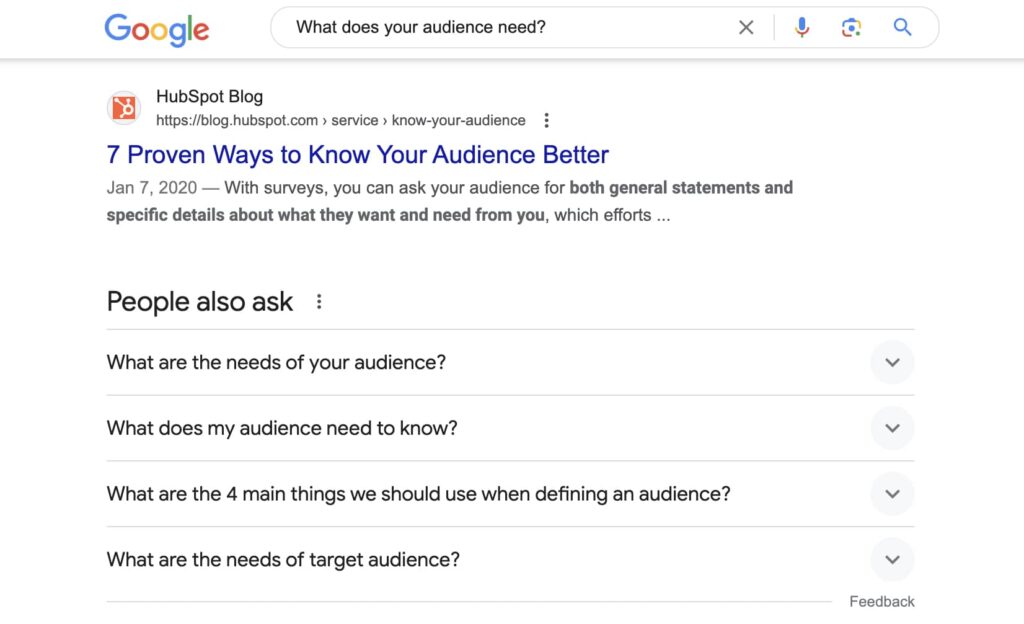
- Analyze Search Volume: Look at the search volume for potential topics to gauge interest and relevance. Utilize tools that can provide insights into how often specific keywords and phrases are searched.
- Utilize Both Generic & Long-Tail Keywords: Create a hierarchy of keywords, starting with broad, generic terms that are tougher to rank for and cascading down to more specific, long-tail keywords. For example, a generic keyword like “SEO” can be the core, with long-tail variations such as “how to improve SEO for small businesses” branching out from it. The long-tail keywords answer the users’ questions and bring them further into your site.
- Organize by Significance & Priority: Hierarchical-ize your keywords by significance and priority, organizing them from general to specific. This structure helps craft content that covers essential topics thoroughly while also delving into niche areas.
- Build Content Clusters: Rather than creating content randomly, focus on creating content clusters. These clusters center around a core topic and include multiple related subtopics. This strategy helps establish your site’s topical authority, which Google just loves.
- Research Search Suggestions & Related Searches: Utilize search engine features like Google’s autocomplete, People Also Search For, and Related Searches suggestions to identify additional content ideas. These suggestions often provide valuable insights into what users are searching for in relation to your core topics.
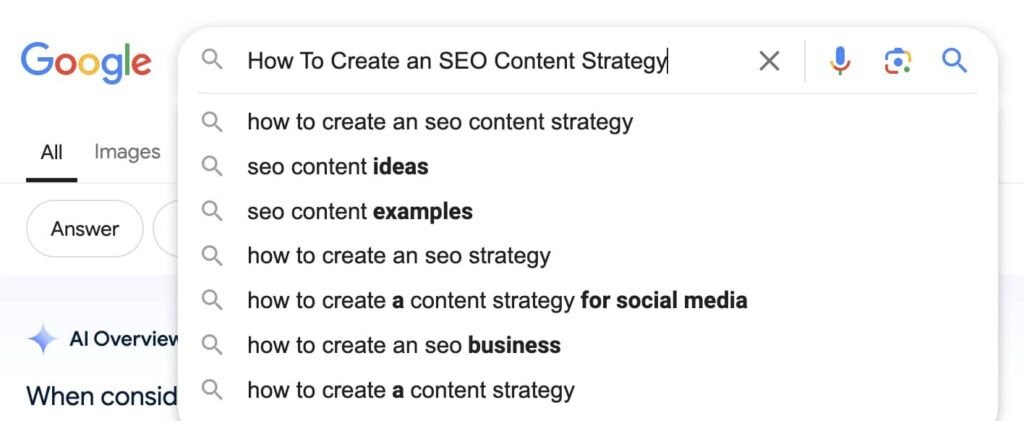
Act with purpose. Create a comprehensive SEO content strategy that attracts more organic traffic and establishes your website as a reliable source of information.
Our Take
Building in-depth, interconnected content that addresses your audience’s needs and queries will put you ahead of the game and attract users to your site.
5. Diversify Your Content
In Step One, we emphasized the importance of getting to know your audience. That includes understanding the type of content they like. Different strokes for different folks, right?
Your audience prefers to consume information in a certain way. What is that? Do they love a good video? Dig infographics? Are they all about that blog life? By diversifying your content types, you’re serving a full-course meal of engagement and appealing to a wider crowd. Plus, mixing it up keeps your brand fresh and versatile.
Read More: 10 Ways To Incorporate Videos into Your Marketing
Our Take
Do your research. Understand what your audience prefers and give that to them. But always keep up with what’s new and what might entice a wider demographic.
6. Build Your Content Plan
Alright, you’ve done the research—now let’s put it to work. The SEO path needs strong content to guide users further into your site.
- Start with high-level, general keywords for your main pages.
- Then, use blog posts to target long-tail, specific searches that users are typing in.
- Your posts will hook users with useful information. Then, internal links will land them on your main pages where the general keywords live.
- Finally, a compelling call to action on those pages will seal the deal and score a conversion.
With this as the general structure of your content plan, fill in a spreadsheet of necessary pages and the blog posts that can support them. Plan out as far as is feasible and schedule when each piece should be completed. Share with your team. And then stick to it!
Our Take
Creating a documented plan of attack with your team keeps everyone on task and headed in the right direction. But it doesn’t stop there. You must update it as standards change or you gain new information. Keep your team in the loop about any changes, and keep moving forward.
7. Create E-E-A-Table Content
Creating authoritative content is imperative if you want to rank high and improve traffic to your site. And it’s all about mastering Google’s E-E-A-T principles: Expertise, Experience, Authoritativeness, and Trustworthiness. These aren’t just buzzwords; they’re the guidelines for delivering content that pleases bots and humans alike.
- Expertise: Google wants to know that you actually know what you’re talking about. Your content should reflect your extensive knowledge (dare we say “expertise”!) in your niche.
- Experience: Show that you’re not a noob. You know the ins and outs of your industry and earned your seat at the table.
- Authoritativeness: This is where your reputation comes in. Are you recognized in your field? Do others consider you a go-to source?
- Trustworthiness: People need to feel they can rely on you for accurate and honest information.
So, how do you nail these?
- Start with an easy-to-navigate and visually appealing website filled with relevant and engaging content.
- Showcase yourself across LinkedIn, Facebook, and your own website with an About page highlighting your credentials and telling your story.
- Interview industry experts and feature their insights prominently.
- Hire specialized writers and give them credit for their work.
- Build your digital footprint by writing guest posts on other authoritative blogs and websites.
“Quality content is how you engage, inform, support, and delight your audiences.”
– Search Engine Land
Our Take
People are looking for accurate, trustworthy information and want to work with reliable and honest businesses. By consistently delivering high-quality content and demonstrating expertise, you’ll build trust and watch those SEO rankings climb. Stop downplaying your talents and put your best face forward.
8. Be Consistent
You may have heard us say it before, but here we go again: Consistency is key, folks! If you want to dominate, you’ve got to regularly produce fresh content. Search engines love active, relevant sites. Consistent updates remind the bots—and your audience—that you are there and you’re reliable.
Keep in mind—consistency is valuable for more than just regularly scheduled content. It is also beneficial to be consistent in the manner in which you provide content and the content itself.
- Use uniform structures
- Push the same/similar keywords found together in your content clusters
- Always speak to your target audience
- Keep your method of communication constant
- Align your metadata
This level of dependability builds authority in your niche and awareness of your brand. Stick to your schedule, keep that content coming, remain consistent across the board, and watch your SEO game soar.
“If you want organic search visibility, rankings, and traffic, you have to commit yourself to the grind of consistently creating optimized content.”
– Search Engine Journal
Our Take
We crave consistency in all of our relationships. Why wouldn’t we want to be able to depend on the brands we love? You’re staying in the public eye and reminding search engines of your relevance—probably one of the easiest wins in your content plan.
9. Don’t Forget to Update Old Content
Think of your SEO content like a garden. You don’t just plant your flowers and abandon them! You must tend to them, make sure they are watered, and get enough light. Sometimes, you’ve got to prune or propagate your plants. The same goes for your content. Your monthly plan should include checking for what can be updated or elaborated upon.
Keeping your content fresh and engaging is non-negotiable. Readers expect current and accurate information every time they click on your site. Regularly review and revamp your posts and pages to ensure they’re doing their best. Remove outdated facts and statistics and replace them with the latest. And please, please, please fix those pesky broken links (both internal and external!).
SEO Content Strategy Example:
The Moz Blog is an awesome example of what we at Twelve Three call the permanent page. Moz regularly updates its blog posts with new insights, updated statistics, and revised best practices to ensure the information remains current and valuable for its audience.
This practice keeps readers coming back for the latest in SEO and digital marketing trends while signaling to search engines that Moz is a reliable and authoritative source of information. Moz consistently ranks exceedingly high, and their audience knows they’re getting trustworthy, up-to-date information.
Permanent pages should expand and evolve, perpetually infused with new insights and updates. Aim to revisit and refresh your content. This keeps your audience engaged and signals to search engines that your site is active and relevant.
Our Take
An untended garden is a mass of overgrown weeds, a maze that bots can’t make sense of and users don’t want to sift through. Tend to your content. Keep it healthy and lush, and it will yield clicks and conversions.
10. Drive Traffic to Your Website From Other Channels
Traffic from diverse sources can positively impact your search rankings—increased engagement signals to search engines that your content is valuable and relevant. Plus, the social sharing buttons on your content pages encourage readers to spread the word, creating more backlinks and social signals that boost your SEO.
Read More: Why You Can’t Ignore SEO for Social
So, use social media and email updates to funnel more visitors to your SEO content. Share your latest blog posts and updates on Facebook, Twitter (or X), and LinkedIn. Create an Instagram post. Send out an email blast or add it to your regular newsletter.
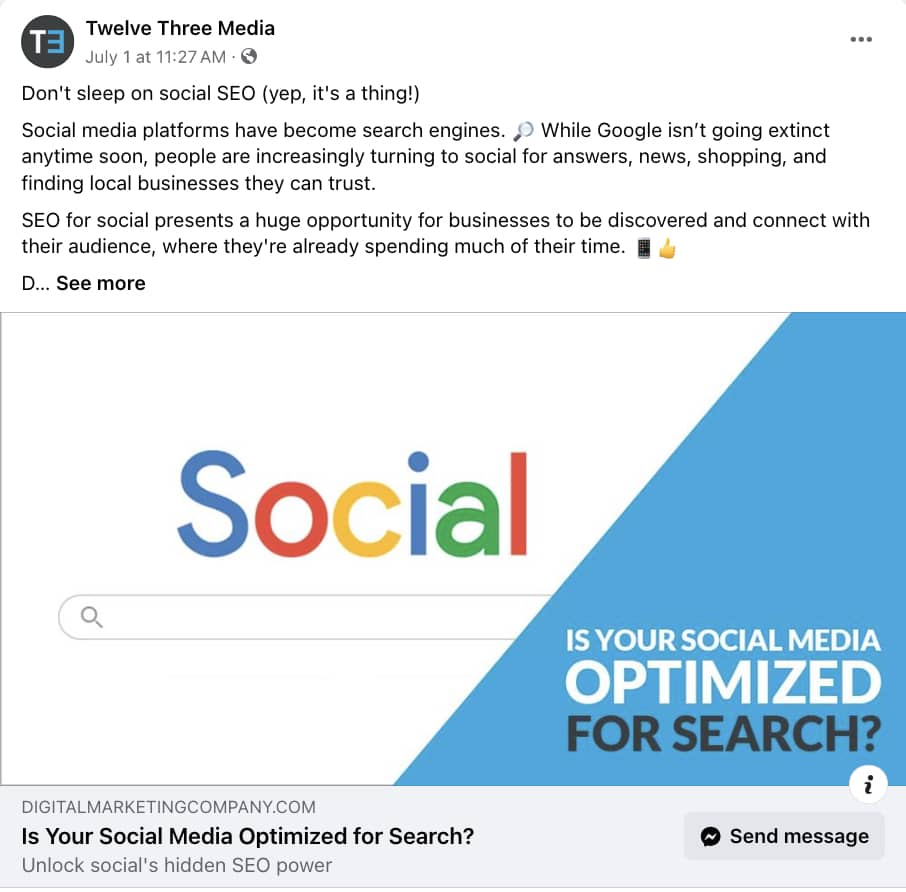
This tactic can broaden your audience while directly engaging with your current followers. Continue the standard of only using compelling and informative content. You want to draw people in and encourage them to click a little further.
Our Take
Have you noticed yet? We are big on utilizing the tools at hand. In digital marketing, we all have access to the same information and implements. If you don’t use them, someone else will. So, give prospective customers and current followers every opportunity to get to your content.
11. Optimize Your Content for SEO
Optimizing your content is about making every element work for you. Here’s how to take your content to eleven and why it matters:
- Keywords in Headers/Subheaders: Place keywords in headers and subheaders to make your content easily crawlable for bots and scannable for readers. Search engines need to understand the structure and relevance of your content, and people need to know they’re going to get the answer to their question.
- Internal/External Linking: Linking to both internal pages and reputable external sites creates a web of connections that search engines love. Internal links help keep visitors on your site longer, while external links to authoritative sources boost your credibility.
- Add Schema: Schema markup provides search engines with structured data about your content, making it easier for them to understand and trust. This can lead to enhanced search results like rich snippets further increasing your visibility.
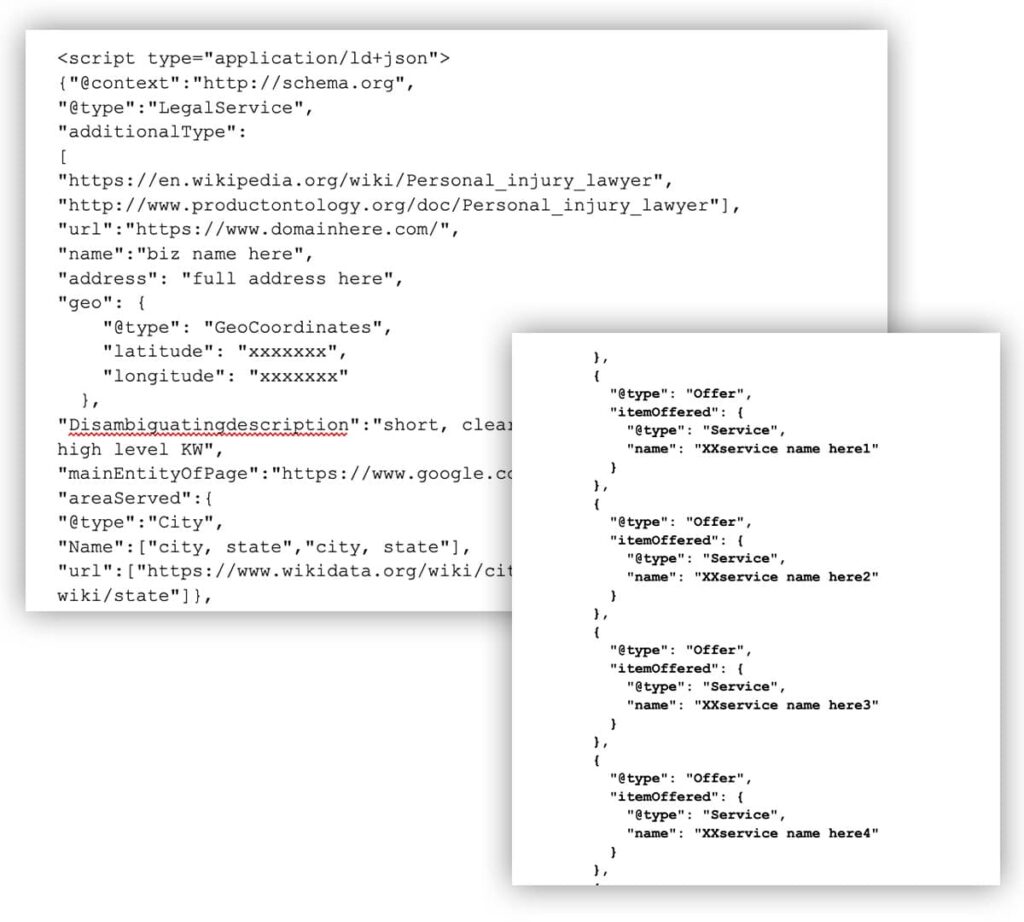
- Title Tags & Meta Descriptions: These are the first impressions in search results, so they need to be well-crafted. Include keywords and appeal to the audience’s questions. A well-thought-out title tag or meta description can significantly increase click-through rates. (Note: Search engines will often switch out page titles and H1s as title tags and body content as meta descriptions. Keep in mind that either could appear when crafting that content as well.)
- Optimize Images: Images should enhance, not hinder, your content. Compress images to speed up load times and use helpful alt text that aligns with your keyword strategy. This can improve your SEO while making your site more accessible and appealing.
- Mobile Optimization: With 63% of consumers using their phones for searches, having a mobile-friendly site is non-negotiable. Fast loading times and an attractive design will keep mobile users happy and engaged.
Each of these elements works together to make your content more appetizing for both search engines and users. Optimizing your content helps it rank higher and provides a better user experience (which helps it rank higher).
Our Take
Simply creating the content doesn’t make it work. You have to work it. Optimizing is like fortifying your foundation and adding a fresh coat of paint. It is completely necessary if you want your content to be understood and consumed.
12. Keep a Watchful Eye on Content Performance
Digital marketing, much like life, never stops moving and changing. You’re wasting your time if you aren’t learning from your own experience. You’ve got to track your performance to know how well your SEO content strategy is working. This is how you refine your approach, make improvements, and ensure your hard work is paying off.
By monitoring key metrics, you can gain valuable insight into user behavior, engagement, and the overall effectiveness of your content. Here are some critical metrics that it might benefit you to track:
- Click-Through Rate (CTR): The percentage of users who click on your link in search results. High CTRs indicate that your titles and descriptions are compelling.
- Traffic: Measures the number of visitors to your site. High traffic indicates strong interest and compelling content.
- Bounce Rate: The percentage of visitors who leave after viewing only one page. While debated, it remains a useful metric when considered in context. A high bounce rate may suggest your content isn’t engaging or relevant enough.
- Time on Page: The average time visitors spend on a page. Longer durations typically mean more engaging and valuable content.
- Session Duration: The total time a visitor spends on your site in one session. Longer sessions can indicate higher engagement and content quality.
- Conversions: Measures the number of visitors who take a desired action, such as making a purchase or signing up for a newsletter. High conversion rates indicate effective content that drives user action.
- Shares: Tracks how often your content is shared on social media. High share counts can amplify your reach and indicate content popularity.
- Backlinks: Links from other sites to your content. It’s important to focus on quality over quantity. Quality backlinks generally mean higher authority and better rankings.
- Indexed Pages: The number of your site’s pages that search engines have indexed. More indexed pages can improve your visibility and search rankings.
- Search Results Rankings: Tracks your position in search engine results for specific keywords. Rankings fluctuate, so use this metric alongside others for a complete picture.
- Keyword Rankings: Measures how well your site ranks for targeted keywords. Better rankings can lead to more organic traffic.
You must establish your Key Performance Indicators (KPIs) to evaluate your content performance effectively. KPIs are specific metrics that align with your business goals. Identifying KPIs helps you focus your tracking efforts on what matters most.
By tracking the metrics that make sense for your niche, you can refine your SEO strategies, create more worthwhile content, and ultimately achieve your business goals.
Our Take
These metrics are tools to help you understand the efficacy of your content strategy for SEO. None of them make or break anything. It is simply about continually learning and adapting. If you want to be the best at what you’re doing, you’ve got to keep moving. And tracking your metrics tells you where your next move should be.
3 Extras
We get it—that was a lot to take in, but if you want to succeed, you’ve got to do the hard things! And we want you to succeed. So, here are just a few more thoughts before we sign off and leave you to it!
- Always stay up-to-date on SEO news and best practices. The more info you have, the better your content will perform.
- Be you the way only you can. Listen, there isn’t a lot that’s new in the world. You will be writing about the same things others are—that’s a given. But try to always do it in your own way. Offer up the thing that only you can. If done well, it will set you apart in both the search engines and people’s minds.
- Don’t stuff keywords!! Yes. That was yelling voice. Don’t do it. No one is falling for it, and it will only hurt you. Quality over quantity every day.
So, What’s the Question?
The first step toward creating a killer content strategy for SEO is to determine what question your audience needs answered. If you haven’t thought about that yet, you’d best get started. We know you can do this (especially since we just told you how). You just need to take that first step.
At Twelve Three Media, we want your company to be killing it all the time. We hope our know-how has given you the confidence to clean up out there. But if you’d prefer a little extra help, we have a team of experts who do this all day. Literally.
Contact us today to create an effective SEO content strategy that increases organic traffic and conversions. We’re ready. Are you?
